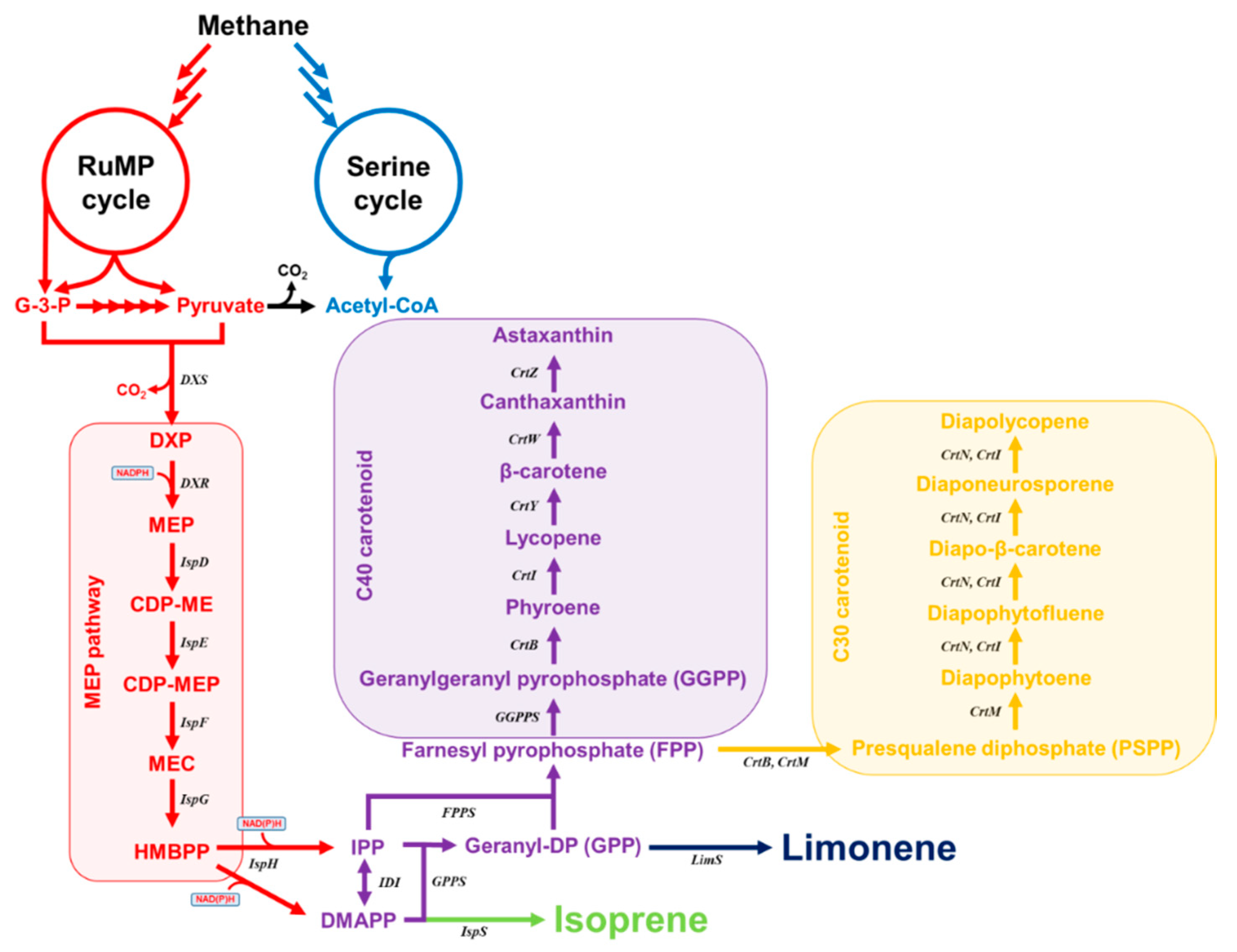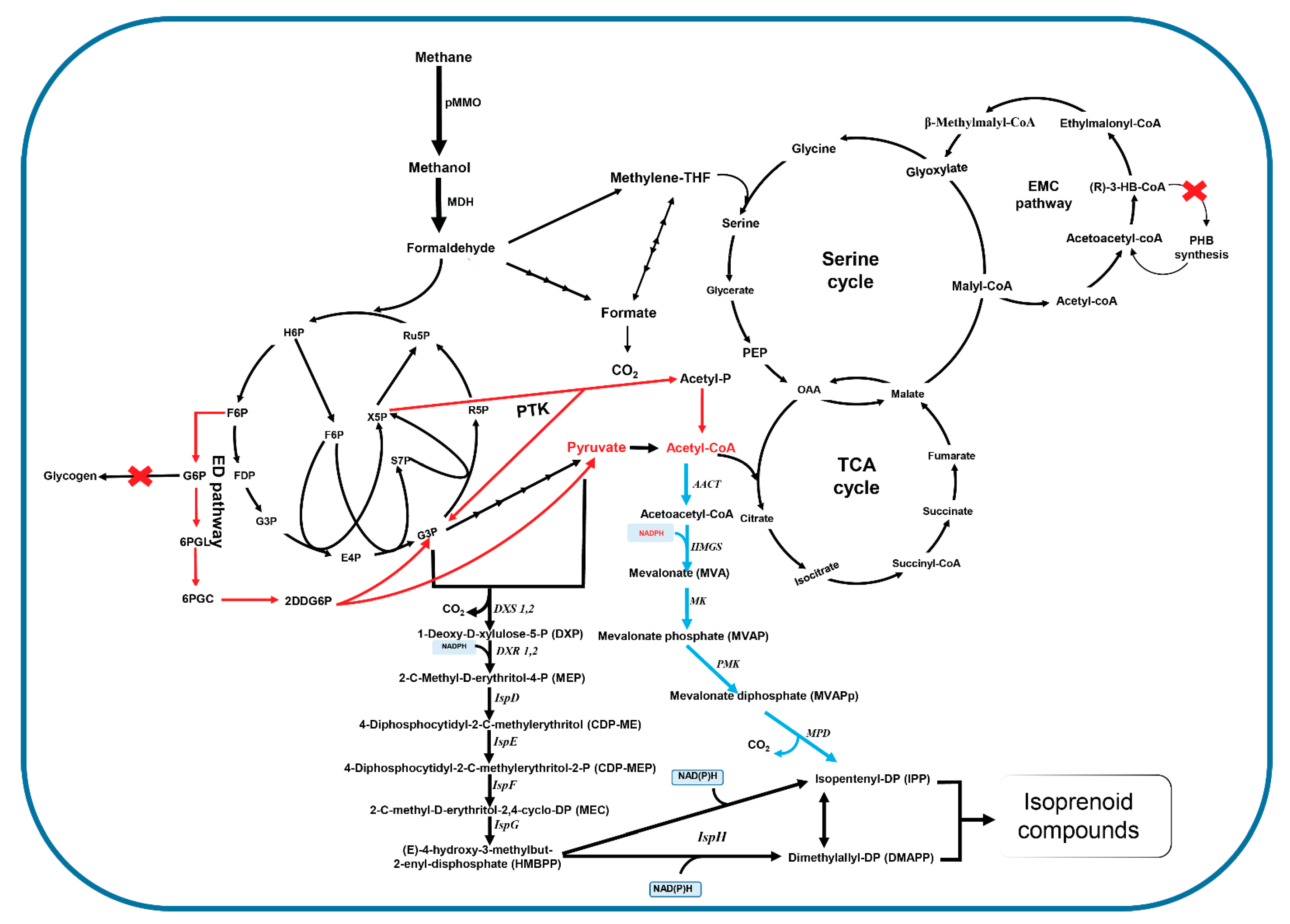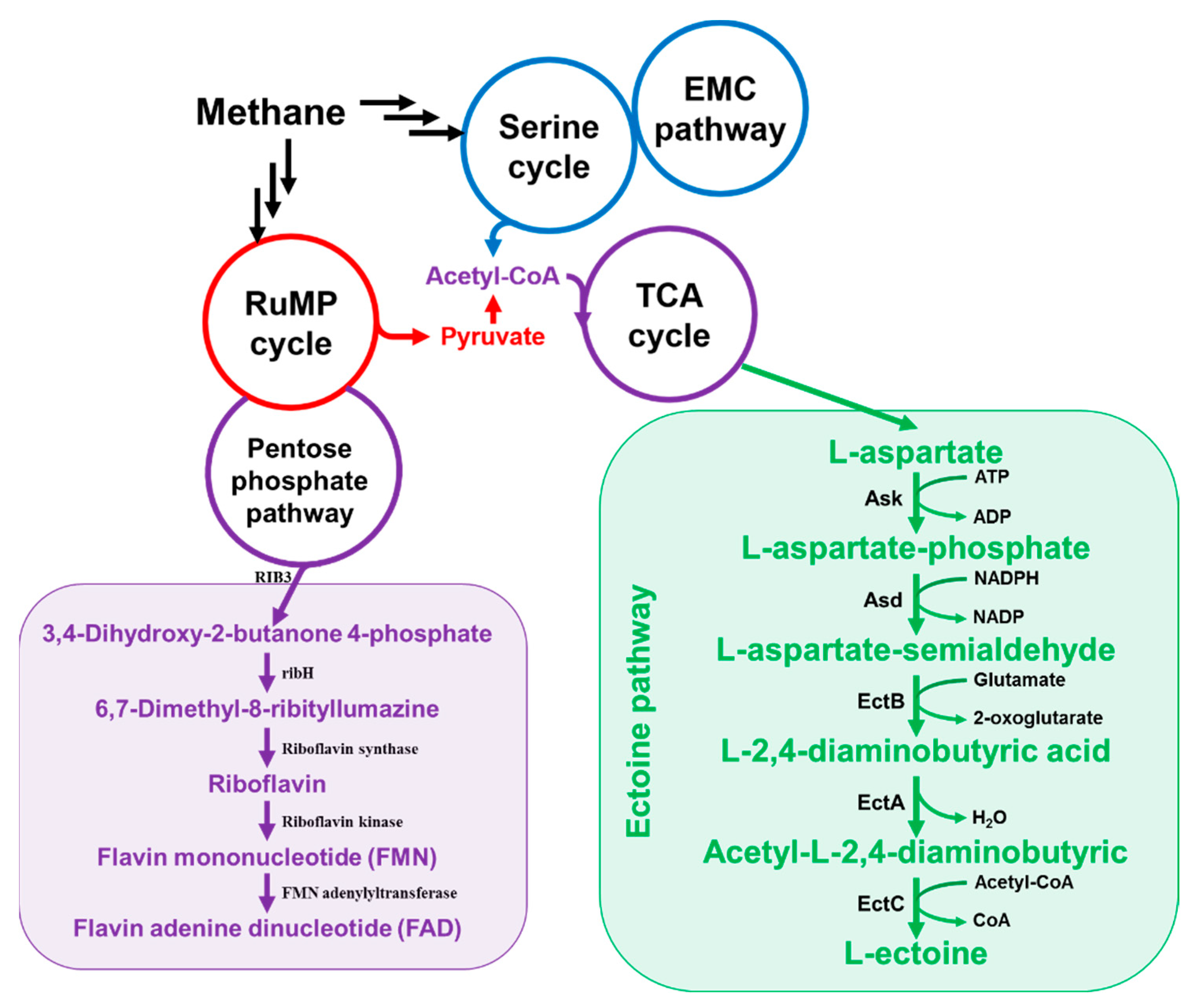Bioproduction of Isoprenoids and Other Secondary Metabolites Using Methanotrophic Bacteria as an Alternative Microbial Cell Factory Option: Current Stage and Future Aspects
Abstract
1. Introduction
2. Methane Metabolism in Methanotrophs
3. Genetic Tool Development for Methanotrophs
4. Isoprenoid Production in Methanotrophs
4.1. Isoprenoid Biosynthesis Via MEP Pathway
4.2. C5: Isoprene
4.3. C10: Limonene
4.4. C30 and C40: Carotenoids
4.5. Advances in Engineering Central Carbon Metabolism to Improve Isoprenoid Production in Methanotrophs
5. Non-Isoprenoid Secondary Metabolite Production from Methane Using Methanotrophs
5.1. Vitamin B2 (Riboflavin)
5.2. Ectoine
6. Future Aspects for Secondary Metabolite Production from Methane Using Methanotrophs
Funding
Conflicts of Interest
References
- Hwang, I.Y.; Hur, D.H.; Lee, J.H.; Park, C.; Chang, I.S.; Lee, J.W.; Lee, E.Y. Batch conversion of methane to methanol using Methylosinus trichosporium OB3b as biocatalyst. J. Microbiol. Biotechnol 2015, 25, 375–380. [Google Scholar] [CrossRef] [PubMed]
- Abbasi, T.; Tauseef, S.; Abbasi, S. Anaerobic digestion for global warming control and energy generation-An overview. Renew. Sustain. Energy Rev. 2012, 16, 3228–3242. [Google Scholar] [CrossRef]
- Kirschke, S.; Bousquet, P.; Ciais, P.; Saunois, M.; Canadell, J.G.; Dlugokencky, E.J.; Bergamaschi, P.; Bergmann, D.; Blake, D.R.; Bruhwiler, L. Three decades of global methane sources and sinks. Nat. Geosci. 2013, 6, 813. [Google Scholar] [CrossRef]
- Nwaoha, C.; Wood, D.A. A review of the utilization and monetization of Nigeria’s natural gas resources: Current realities. J. Nat. Gas Sci. Eng. 2014, 18, 412–432. [Google Scholar] [CrossRef]
- Conrado, R.J.; Gonzalez, R. Chemistry. Envisioning the bioconversion of methane to liquid fuels. Science 2014, 343, 621–623. [Google Scholar] [CrossRef]
- Haynes, C.A.; Gonzalez, R. Rethinking biological activation of methane and conversion to liquid fuels. Nat. Chem. Biol. 2014, 10, 331. [Google Scholar] [CrossRef]
- Han, J.; Ahn, C.; Mahanty, B.; Kim, C. Partial oxidative conversion of methane to methanol through selective inhibition of methanol dehydrogenase in methanotrophic consortium from landfill cover soil. Appl. Biochem. Biotechnol. 2013, 171, 1487–1499. [Google Scholar] [CrossRef]
- Hwang, I.Y.; Nguyen, A.D.; Nguyen, T.T.; Nguyen, L.T.; Lee, O.K.; Lee, E.Y. Biological conversion of methane to chemicals and fuels: Technical challenges and issues. Appl. Microbiol. Biotechnol. 2018, 102, 3071–3080. [Google Scholar] [CrossRef]
- Nguyen, A.D.; Hwang, I.Y.; Lee, O.K.; Kim, D.; Kalyuzhnaya, M.G.; Mariyana, R.; Hadiyati, S.; Kim, M.S.; Lee, E.Y. Systematic metabolic engineering of Methylomicrobium alcaliphilum 20Z for 2, 3-butanediol production from methane. Metab. Eng. 2018, 47, 323–333. [Google Scholar] [CrossRef]
- Khmelenina, V.N.; Rozova, N.; But, C.Y.; Mustakhimov, I.I.; Reshetnikov, A.S.; Beschastnyi, A.P.; Trotsenko, Y.A. Biosynthesis of secondary metabolites in methanotrophs: biochemical and genetic aspects (review). Appl. Biochem. Microbiol. 2015, 51, 140–150. [Google Scholar] [CrossRef]
- Fei, Q.; Guarnieri, M.T.; Tao, L.; Laurens, L.M.; Dowe, N.; Pienkos, P.T. Bioconversion of natural gas to liquid fuel: opportunities and challenges. Biotechnol Adv 2014, 32, 596–614. [Google Scholar] [CrossRef] [PubMed]
- Wang, C.; Zada, B.; Wei, G.; Kim, S.W. Metabolic engineering and synthetic biology approaches driving isoprenoid production in Escherichia coli. Bioresour. Technol. 2017, 241, 430–438. [Google Scholar] [CrossRef]
- Tippmann, S.; Chen, Y.; Siewers, V.; Nielsen, J. From flavors and pharmaceuticals to advanced biofuels: production of isoprenoids in Saccharomyces cerevisiae. Biotechnol. J. 2013, 8, 1435–1444. [Google Scholar] [CrossRef]
- Li, Y.; Pfeifer, B.A. Heterologous production of plant-derived isoprenoid products in microbes and the application of metabolic engineering and synthetic biology. Curr. Opin. Plant Biol. 2014, 19, 8–13. [Google Scholar] [CrossRef] [PubMed]
- Murrell, J.C.; McDonald, I.R.; Bourne, D.G. Molecular methods for the study of methanotroph ecology. FEMS Microbiol. Ecol. 1998, 27, 103–114. [Google Scholar] [CrossRef]
- Akberdin, I.R.; Thompson, M.; Kalyuzhnaya, M.G. Systems Biology and Metabolic Modeling of C1-Metabolism. In Methane Biocatalysis: Paving the Way to Sustainability; Springer: Cham, Switzerland, 2018; pp. 99–115. [Google Scholar]
- Kalyuzhnaya, M.G.; Puri, A.W.; Lidstrom, M.E. Metabolic engineering in methanotrophic bacteria. Metab. Eng. 2015, 29, 142–152. [Google Scholar] [CrossRef] [PubMed]
- Lee, O.K.; Hur, D.H.; Nguyen, D.T.N.; Lee, E.Y. Metabolic engineering of methanotrophs and its application to production of chemicals and biofuels from methane. Biofuel Bioprod. Biorefin. 2016, 10, 848–863. [Google Scholar] [CrossRef]
- Hakemian, A.S.; Rosenzweig, A.C. The biochemistry of methane oxidation. Annu. Rev. Biochem. 2007, 76, 223–241. [Google Scholar] [CrossRef]
- Hanson, R.S.; Hanson, T.E. Methanotrophic bacteria. Microbiol. Rev. 1996, 60, 439–471. [Google Scholar]
- Chistoserdova, L.; Kalyuzhnaya, M.G. Current trends in methylotrophy. Trends Microbiol. 2018, 26, 703–714. [Google Scholar] [CrossRef]
- Dedysh, S.N.; Dunfield, P.F. Facultative and obligate methanotrophs: how to identify and differentiate them. In Methods in Enzymology; Elsevier: Amsterdam, The Netherlands, 2011; Volume 495, pp. 31–44. [Google Scholar]
- Trotsenko, Y.A.; Murrell, J.C. Metabolic aspects of aerobic obligate methanotrophy? Adv. Appl. Microbiol. 2011, 63, 183. [Google Scholar]
- Nguyen, A.D.; Hwang, I.Y.; Lee, O.K.; Hur, D.H.; Jeon, Y.C.; Hadiyati, S.; Kim, M.; Yoon, S.H.; Jeong, H.; Lee, E.Y. Functional analysis of Methylomonas sp. DH-1 genome as a promising biocatalyst for bioconversion of methane to valuable chemicals. Catalysts 2018, 8, 117. [Google Scholar]
- Fu, Y.; Li, Y.; Lidstrom, M. The oxidative TCA cycle operates during methanotrophic growth of the Type I methanotroph Methylomicrobium buryatense 5GB1. Metab. Eng. 2017, 42, 43–51. [Google Scholar] [CrossRef] [PubMed]
- Kalyuzhnaya, M.G.; Yang, S.; Rozova, O.N.; Smalley, N.E.; Clubb, J.; Lamb, A.; Gowda, G.N.; Raftery, D.; Fu, Y.; Bringel, F. Highly efficient methane biocatalysis revealed in a methanotrophic bacterium. Nat. Commun. 2013, 4, 2785. [Google Scholar] [CrossRef] [PubMed]
- Nguyen, A.D.; Park, J.Y.; Hwang, I.Y.; Hamilton, R.; Kalyuzhnaya, M.G.; Kim, D.; Lee, E.Y. Genome-scale evaluation of core one-carbon metabolism in gammaproteobacterial methanotrophs grown on methane and methanol. Metab. Eng. 2019. [Google Scholar] [CrossRef] [PubMed]
- Kalyuzhanaya, M.G.; Yang, S.; Matsen, J.B.; Konopka, M.; Green-Saxena, A.; Clubb, J.; Sadilek, M.; Orphan, V.J.; Beck, D. Global molecular analyses of methane metabolism in methanotrophic alphaproteobacterium, Methylosinus trichosporium OB3b. Part II. Metabolomics and 13C-labeling study. Front. Microbiol. 2013, 4, 70. [Google Scholar]
- Lee, O.K.; Nguyen, D.T.; Lee, E.Y. Metabolic Engineering of Methanotrophs for the Production of Chemicals and Fuels. In Methanotrophs; Springer: Cham, Switzerland, 2019; pp. 163–203. [Google Scholar]
- Ishikawa, M.; Yokoe, S.; Kato, S.; Hori, K. Efficient counterselection for Methylococcus capsulatus (Bath) by using a mutated pheS gene. Appl. Environ. Microbiol. 2018, 84, 1875. [Google Scholar] [CrossRef] [PubMed]
- Ro, S.Y.; Rosenzweig, A.C. Recent advances in the genetic manipulation of Methylosinus trichosporium OB3b. In Methods in Enzymology; Elsevier: Amsterdam, The Netherlands, 2018; Volume 605, pp. 335–349. [Google Scholar]
- Tapscott, T.; Guarnieri, M.T.; Henard, C.A. Development of a CRISPR/Cas9 system for Methylococcus capsulatus in vivo gene editing. Appl Environ Microbiol 2019, 85, 340. [Google Scholar] [CrossRef]
- Zhao, L.; Chang, W.; Xiao, Y.; Liu, H.; Liu, P. Methylerythritol phosphate pathway of isoprenoid biosynthesis. Annu. Rev. Biochem. 2013, 82, 497–530. [Google Scholar] [CrossRef]
- Odom, A.R. Five questions about non-mevalonate isoprenoid biosynthesis. PLoS Pathog. 2011, 7, e1002323. [Google Scholar] [CrossRef]
- Banerjee, A.; Sharkey, T. Methylerythritol 4-phosphate (MEP) pathway metabolic regulation. Nat. Prod. Rep. 2014, 31, 1043–1055. [Google Scholar] [CrossRef]
- Ajikumar, P.K.; Xiao, W.H.; Tyo, K.E.; Wang, Y.; Simeon, F.; Leonard, E.; Mucha, O.; Phon, T.H.; Pfeifer, B.; Stephanopoulos, G. Isoprenoid pathway optimization for Taxol precursor overproduction in Escherichia coli. Science 2010, 330, 70–74. [Google Scholar] [CrossRef]
- Niu, F.; Lu, Q.; Bu, Y.; Liu, J. Metabolic engineering for the microbial production of isoprenoids: Carotenoids and isoprenoid-based biofuels. Synth. Syst. Biotechnol. 2017, 2, 167–175. [Google Scholar] [CrossRef] [PubMed]
- Nguyen, A.D.; Kim, D.; Lee, E.Y. A comparative transcriptome analysis of the novel obligate methanotroph Methylomonas sp. DH-1 reveals key differences in transcriptional responses in C1 and secondary metabolite pathways during growth on methane and methanol. BMC Genomics 2019, 20, 130. [Google Scholar]
- Akberdin, I.R.; Thompson, M.; Hamilton, R.; Desai, N.; Alexander, D.; Henard, C.A.; Guarnieri, M.T.; Kalyuzhnaya, M.G. Methane utilization in Methylomicrobium alcaliphilum 20Z R: A systems approach. Sci. Rep. 2018, 8, 2512. [Google Scholar] [CrossRef] [PubMed]
- Kuzuyama, T. Mevalonate and nonmevalonate pathways for the biosynthesis of isoprene units. Biosci. Biotechnol. Biochem. 2002, 66, 1619–1627. [Google Scholar] [CrossRef]
- Clement, N.D.; Routaboul, L.; Grotevendt, A.; Jackstell, R.; Beller, M. Development of palladium–carbene catalysts for telomerization and dimerization of 1, 3-dienes: From basic research to industrial applications. Chem. Eur. J. 2008, 14, 7408–7420. [Google Scholar]
- Julsing, M.K.; Rijpkema, M.; Woerdenbag, H.J.; Quax, W.J.; Kayser, O. Functional analysis of genes involved in the biosynthesis of isoprene in Bacillus subtilis. Appl. Microbiol. Biotechnol. 2007, 75, 1377–1384. [Google Scholar] [CrossRef] [PubMed]
- Whited, G.M.; Feher, F.J.; Benko, D.A.; Cervin, M.A.; Chotani, G.K.; McAuliffe, J.C.; LaDuca, R.J.; Ben-Shoshan, E.; Sanford, K.J. Technology update: Development of a gas-phase bioprocess for isoprene-monomer production using metabolic pathway engineering. Ind. Biotechnol. 2010, 6, 152–163. [Google Scholar] [CrossRef]
- Song, J.; Cho, K.K.; Lee, K.S.; La, Y.H.; Kalyuzhnaya, M. Method for Producing Isoprene Using Recombinant Halophilic Methanotroph. U.S. Patent US20170211100A1, 27 July 2017. [Google Scholar]
- Dicosimo, D.J.; Koffas, M.; Odom, J.M.; Wang, S. Production of cyclic terpenoids. U.S. Patent US6818424B2, 2004. [Google Scholar]
- Rick, W.Y.; Yao, H.; Stead, K.; Wang, T.; Tao, L.; Cheng, Q.; Sharpe, P.L.; Suh, W.; Nagel, E.; Arcilla, D. Construction of the astaxanthin biosynthetic pathway in a methanotrophic bacterium Methylomonas sp. strain 16a. J. Ind. Microbiol. Biotechnol. 2007, 34, 289. [Google Scholar]
- Sharpe, P.L.; DiCosimo, D.; Bosak, M.D.; Knoke, K.; Tao, L.; Cheng, Q.; Rick, W.Y. Use of transposon promoter-probe vectors in the metabolic engineering of the obligate methanotroph Methylomonas sp. strain 16a for enhanced C40 carotenoid synthesis. Appl. Environ. Microbiol. 2007, 73, 1721–1728. [Google Scholar] [CrossRef]
- Balasubramanian, R.; Levinson, B.T.; Rosenzweig, A.C. Secretion of flavins by three species of methanotrophic bacteria. Appl. Environ. Microbiol. 2010, 76, 7356–7358. [Google Scholar] [CrossRef]
- Cantera, S.; Lebrero, R.; Rodríguez, E.; García-Encina, P.A.; Muñoz, R. Continuous abatement of methane coupled with ectoine production by Methylomicrobium alcaliphilum 20Z in stirred tank reactors: A step further towards greenhouse gas biorefineries. J. Clean. Prod. 2017, 152, 134–141. [Google Scholar] [CrossRef]
- Cantera Ruiz de Pellón, S.; Lebrero Fernández, R.; Rodríguez, S.; García Encina, P.A.; Muñoz Torre, R. Ectoine bio-milking in methanotrophs: A step further towards methane-based bio-refineries into high added-value products. Chem. Eng. J. 2017, 328, 44–48. [Google Scholar]
- Sun, J. D-Limonene: Safety and clinical applications. Altern. Med. Rev. 2007, 12, 259. [Google Scholar] [PubMed]
- Noviendri, D.; Hasrini, R.F.; Octavianti, F. Carotenoids: Sources, medicinal properties and their application in food and nutraceutical industry. J. Med. Plant. Res. 2011, 5, 7119–7131. [Google Scholar]
- Umeno, D.; Tobias, A.V.; Arnold, F.H. Diversifying carotenoid biosynthetic pathways by directed evolution. Microbiol. Mol. Biol. Rev. 2005, 69, 51–78. [Google Scholar] [CrossRef] [PubMed]
- Guo, W.; Li, D.; He, R.; Wu, M.; Chen, W.; Gao, F.; Zhang, Z.; Yao, Y.; Yu, L.; Chen, S. Synthesizing value-added products from methane by a new Methylomonas. J. Appl. Microbiol. 2017, 123, 1214–1227. [Google Scholar] [CrossRef] [PubMed]
- Kim, S.H.; Kim, M.S.; Lee, B.Y.; Lee, P.C. Generation of structurally novel short carotenoids and study of their biological activity. Sci. Rep. 2016, 6, 21987. [Google Scholar] [CrossRef] [PubMed]
- Liu, H.; Sun, Y.; Ramos, K.R.M.; Nisola, G.M.; Valdehuesa, K.N.G.; Lee, W.; Park, S.J.; Chung, W. Combination of Entner-Doudoroff pathway with MEP increases isoprene production in engineered Escherichia coli. PLoS ONE 2013, 8, e83290. [Google Scholar] [CrossRef]
- Henard, C.A.; Smith, H.K.; Guarnieri, M.T. Phosphoketolase overexpression increases biomass and lipid yield from methane in an obligate methanotrophic biocatalyst. Metab. Eng. 2017, 41, 152–158. [Google Scholar] [CrossRef]
- Sonntag, F.; Kroner, C.; Lubuta, P.; Peyraud, R.; Horst, A.; Buchhaupt, M.; Schrader, J. Engineering Methylobacterium extorquens for de novo synthesis of the sesquiterpenoid α-humulene from methanol. Metab. Eng. 2015, 32, 82–94. [Google Scholar] [CrossRef]
- Schwechheimer, S.K.; Park, E.Y.; Revuelta, J.L.; Becker, J.; Wittmann, C. Biotechnology of riboflavin. Appl. Microbiol. Biotechnol. 2016, 100, 2107–2119. [Google Scholar] [CrossRef]
- Kato, T.; Park, E.Y. Riboflavin production by Ashbya gossypii. Biotechnol. Lett. 2012, 34, 611–618. [Google Scholar] [CrossRef]
- Strong, P.; Kalyuzhnaya, M.; Silverman, J.; Clarke, W. A methanotroph-based biorefinery: Potential scenarios for generating multiple products from a single fermentation. Bioresour. Technol. 2016, 215, 314–323. [Google Scholar] [CrossRef] [PubMed]
- Kuhlmann, A.U.; Bremer, E. Osmotically regulated synthesis of the compatible solute ectoine in Bacillus pasteurii and related Bacillus spp. Appl. Environ. Microbiol. 2002, 68, 772–783. [Google Scholar] [CrossRef] [PubMed]
- Reshetnikov, A.S.; Khmelenina, V.N.; Trotsenko, Y.A. Characterization of the ectoine biosynthesis genes of haloalkalotolerant obligate methanotroph “Methylomicrobium alcaliphilum 20Z”. Arch. Microbiol. 2006, 184, 286–297. [Google Scholar] [CrossRef] [PubMed]
- Mustakhimov, I.I.; Reshetnikov, A.S.; Glukhov, A.S.; Khmelenina, V.N.; Kalyuzhnaya, M.G.; Trotsenko, Y.A. Identification and characterization of EctR1, a new transcriptional regulator of the ectoine biosynthesis genes in the halotolerant methanotroph Methylomicrobium alcaliphilum 20Z. J. Bacteriol. 2010, 192, 410–417. [Google Scholar] [CrossRef]



| dxs1 | dxs2 | dxr1 | dxr2 | ispD | ispE | ispF | ispG | ispH | idi | |
|---|---|---|---|---|---|---|---|---|---|---|
| Methylomonas sp. DH-1 | x | x | x | x | x | x | x | x | ||
| Methylomicrobium alcaliphilum 20Z | x | x | x | x | x | x | x | x | ||
| Methylomicrobium buryatense 5GB1 | x | x | x | x | x | x | x | x | ||
| Methylomonas methanica MC09 | x | x | x | x | x | x | x | x | ||
| Methylosinus trichosporium OB3b | x | x | x | x | x | x | x | x | ||
| Escherichia coli K12 MG1655 | x | x | x | x | x | x | x | x | ||
| Bacillus subtilis | x | x | x | x | x | x | x | x |
| Product | Strain | C1 Feedstock | Process | Productivity | Reference |
|---|---|---|---|---|---|
| Isoprene | Methylomicrobium alcaliphilum 20Z | Methanol | Expression of the isoprene synthase (ispS) | 50 μg/mL | [44] |
| Limonene | Methylomonas sp. 16a | Methane | Expression of the limonene synthase (limS) | 0.5 ppm | [45] |
| Astaxanthin | Methylomonas sp. 16a | Methane | Expression of the geranylgeranyl diphosphate synthase (crtE), phytoene synthase (crtB), phytoene desaturase (crtI), lycopene cyclase (crtY), beta-carotene ketolase (crtW), and beta-carotene hydroxylase (crtZ) genes | 2.4 mg/gDCW | [46] |
| Astaxanthin | Methylomonas sp. 16a | Methane | Use of transposon promoter-probe vectors for enhancing C40 carotenoid | 2 mg/gDCW | [47] |
| Vitamin B2 | Methylocystis sp. Strain M | Methane | Exponential phase | 0.05 μM | [48] |
| Late exponential phase | 0.056 μM | ||||
| Stationary phase | 0.102 μM | ||||
| Iron deficient condition | 0.145 μM | ||||
| Ectoine | Methylomicrobium alcaliphilum 20Z | Methane | Stirred tank reactors (non-sterile conditions) varies depending on the NaCl concentration and the stirring rates. | 16.5–37.4 mg/g cell | [49] |
| bio-milking process | 70.4 mg/g cell | [50] |
© 2019 by the authors. Licensee MDPI, Basel, Switzerland. This article is an open access article distributed under the terms and conditions of the Creative Commons Attribution (CC BY) license (http://creativecommons.org/licenses/by/4.0/).
Share and Cite
Jeon, Y.C.; Nguyen, A.D.; Lee, E.Y. Bioproduction of Isoprenoids and Other Secondary Metabolites Using Methanotrophic Bacteria as an Alternative Microbial Cell Factory Option: Current Stage and Future Aspects. Catalysts 2019, 9, 883. https://doi.org/10.3390/catal9110883
Jeon YC, Nguyen AD, Lee EY. Bioproduction of Isoprenoids and Other Secondary Metabolites Using Methanotrophic Bacteria as an Alternative Microbial Cell Factory Option: Current Stage and Future Aspects. Catalysts. 2019; 9(11):883. https://doi.org/10.3390/catal9110883
Chicago/Turabian StyleJeon, Young Chan, Anh Duc Nguyen, and Eun Yeol Lee. 2019. "Bioproduction of Isoprenoids and Other Secondary Metabolites Using Methanotrophic Bacteria as an Alternative Microbial Cell Factory Option: Current Stage and Future Aspects" Catalysts 9, no. 11: 883. https://doi.org/10.3390/catal9110883
APA StyleJeon, Y. C., Nguyen, A. D., & Lee, E. Y. (2019). Bioproduction of Isoprenoids and Other Secondary Metabolites Using Methanotrophic Bacteria as an Alternative Microbial Cell Factory Option: Current Stage and Future Aspects. Catalysts, 9(11), 883. https://doi.org/10.3390/catal9110883






